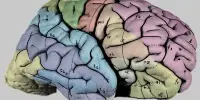Migraine sufferers appear to have a hyper-excitable visual cortex, according to researchers at the Universities of Birmingham and Lancaster. Migraines are intense and chronic headaches that are frequently accompanied by heightened sensitivity to visual or other sensory stimuli. The exact causes of severe headaches are unknown, but scientists suspect they are caused by transitory changes in the brain’s neurotransmitters, neurons, or blood vessels.
Using MRI images, researchers discovered that migraine sufferers have a thinner and smaller cortex in key brain regions connected to pain processing than headache-free adults. The cortex is the brain’s outer layer. That’s unclear what it all implies. However, the researchers believe that some elements of brain development may predispose some people to migraines, and that migraine attacks cause additional brain modifications.
Researchers set out to test a theory that at least part of the answer rests in the visual cortex, the area of our brain that is responsible for vision, in a new study published in the journal Neuroimage: Clinical.
Dr. Terence Chun Yuen Fong, the study’s primary author, explained: “Most migraineurs report experiencing anomalous visual sensations in their daily lives, such as simple hallucinations, visual discomforts, and increased light sensitivity. This, we feel, suggests a relationship between migraine symptoms and visual brain anomalies. Our findings give the first evidence for this notion by identifying a distinct brain response pattern in migraineurs.”
Our findings suggest that there are likely particular irregularities in the way migraine sufferers’ visual cortex interprets information from the outside environment. However, we feel that this is only part of the picture, because similar patterns of activity can be found in non-migraineurs who are sensitive to particular visual stimuli.
Dr. Ali Mazaheri
Researchers from the University of Birmingham’s Centre for Human Brain Health and School of Psychology, as well as Lancaster University’s Department of Psychology, conducted the study. The researchers conducted an experiment on 60 participants, half of whom were ‘migraineurs,’ or migraine sufferers on a regular basis. Participants were shown a striped grating pattern and asked to judge it based on whether it was painful to look at or if it caused any visual phenomena when seen.
In a subsequent test, the individuals were subjected to an electroencephalogram (EEG), which allowed the researchers to detect and record brain wave patterns while visual stimuli were presented. In both tests, the researchers found a larger response in the visual cortex among the group of migraine sufferers when participants were presented with the gratings.
The study also took into account results from a subgroup of non-migraineurs — participants who reported additional visual disturbances, a common feature of migraines. Surprisingly, it was found that these participants also showed hyperexcitability in the response of their visual cortex.

Dr. Ali Mazaheri, the paper’s principal author, explains: “Our findings suggest that there are likely particular irregularities in the way migraine sufferers’ visual cortex interprets information from the outside environment. However, we feel that this is only part of the picture, because similar patterns of activity can be found in non-migraineurs who are sensitive to particular visual stimuli.”
The group will be monitored over time to determine if their response to visual stimuli changes as they come closer to having a migraine, and to try to map what other physiological changes may be occurring. This will pave the way to being able to forecast migraine headaches and help prevent their onset.
Chronic migraine is a very disabling disease that has a significant influence on migraine patients’ socioeconomic functioning and quality of life. Chronic migraine typically develops from episodic migraine, which gradually increases in attack frequency, lending credence to the notion of migraine as a spectrum condition. The pathophysiological mechanisms underlying migraine chronification remain unknown.
Chronic migraine patients, like episodic migraine patients, have broad functional and anatomical changes in pain-related cortical and subcortical brain areas. Chronic migraine sufferers, on the other hand, have a more severe malfunction of the pain inhibitory network as well as increased sensitization of the central pain pathways, which could explain their increased susceptibility to migraine attacks.
















